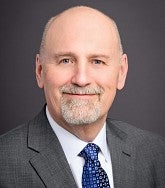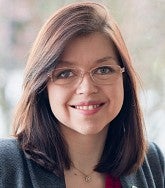A Teamwork Touchdown: UO Will Score in Big Ten Academic Alliance
The consortium offers schools resources for upping the academic game
By Matt Cooper • Illustration by David Gill • July 3, 2024
7 min read
It was one thing to dream about all the schools in the Big Ten conference collaborating on instruction of world languages.
Convincing them to get on board would be quite another.
That’s the situation Chris Long faced in 2016. The dean of the College of Arts & Letters at Michigan State University saw potential in an offer by the Andrew W. Mellon Foundation to support instruction of less commonly taught languages across the conference.

But would the deans of the other schools agree? Would they embrace adopting new technologies to teach languages online? Who would solve the Rubik’s Cube of coordinating courses conference-wide so students at any school could reach higher levels of proficiency in Swahili, Hindi, or Hebrew? With wide-ranging strengths in language teaching and learning across the conference, what if the other schools’ priorities differed from those at Michigan State?
Long didn’t worry. Yes, there was some reticence, but mostly his Big Ten peers met him with a cooperative spirit born of trust; decades of collaboration within a consortium of the schools in the conference had created a culture in which the idea could succeed. It is standard operating procedure in the Big Ten for each school’s leaders to meet regularly with their peers across the conference to troubleshoot problems, identify efficiencies, and share resources.
The deans recognized the power of Long’s vision, and the rest is history. The foundation awarded $1.2 million to launch a Big Ten partnership for online instruction of less commonly taught languages—and then $2.5 million to expand the project to support indigenous languages. “Those grants were successful because the relationships among the deans within the conference are rooted in trust,” Long says. “Collaboration requires trust, and we had long-standing relationships of trust within that deans’ group.”
Trust is the foundation of this sixty-five-year-old consortium called the Big Ten Academic Alliance.
In joining the conference, the University of Oregon will also join this alliance—and will be able to tap resources that include leadership groups, one of the largest library collections in the world, and a network for the study and preservation of less commonly taught languages.

A “unicorn” for leadership in academia
To see the value of the alliance, look no farther than the leadership in Johnson Hall.
Long, who joined the university in June as provost, and President Karl Scholz are alumni of the alliance’s peer groups and other programs: Scholz during his tenure as a provost and dean at University of Wisconsin-Madison and Long, first at Penn State University and then the last nine years at Michigan State, where he was dean of the arts and letters college and honors college.
During the COVID-19 pandemic, for example, Scholz and provosts of the other Big Ten schools were meeting as often as twice weekly on questions such as testing options and best practices for closing and reopening campuses.
“Others have tried to replicate the alliance but no one else has,” Scholz says. “There’s a spirit of cooperation among these large, mostly public research institutions that gives the alliance a coherence. People have seen the value of it, so they buy into it.”
Funded by member dues, the alliance is built on the collaboration that happens within the regular meetings of the many peer groups: provosts, deans, librarians, and academic and administrative leaders across the breadth of university functions.

Like Long, many of these officers also participated in alliance leadership development programs along their rise to higher posts. Across the alliance, half of top positions—presidents, provosts, deans—are held by current or previous participants of these programs.
Keith Marshall, alliance executive director, credits the consortium’s success to the peer nature of Big Ten schools—all large research universities with similar challenges and opportunities—and a culture of trust built over time. Even in the über-competitive realm of drawing students, Marshall notes, Big Ten schools share secrets of success with each other rather than hold them close.
“The people of the Big Ten universities see that they’re part of something bigger than their university,” Marshall says. “No other collection of large research universities is doing what we’re doing, anywhere. We are a unicorn.”

BIG Collection is among the world’s largest libraries
In what’s been called an unprecedented move for independent universities, the collections of the Big Ten university libraries are being united into a single digital and physical library, shared and fully networked, called the BIG Collection.
The project places at the fingertips of each Big Ten university a collection breathtaking in size—nearly one-quarter of all print titles in North America. Once complete it will be the third largest collection in the world, trailing only those in the Library of Congress and the British Library, according to Maurice York, director of library initiatives for the alliance.
The borrowing network already moves tens of thousands of volumes a year to students, faculty, and researchers across the Big Ten. Through a massive digitization effort and sharing agreements, York says, the completion of the BIG Collection will result in “any content, from anywhere, to anyone, now and in the future.”

Alicia Salaz, vice provost and university librarian for the UO, says the collection will enable each university to share digital surrogates of unique assets without putting anything in the mail. The UO, for example, could make available robust Chinese, Japanese, and Thai language materials, aerial photography collections, the original Oregon Trail Diaries, and books produced before the invention of the printing press.
Conversely, the UO will have access to unique—and otherwise expensive—collections of Big Ten schools. Salaz, noted, for example, that because many Big Ten schools have strong medical and engineering programs, their libraries have a wealth of resources that will serve the UO as it expands biomedical- and engineering-related research.
“Those libraries will now also be our libraries,” Salaz says. “It will really build on existing partnerships we have to share those kinds of resources with local partners like Oregon Health & Science University in Portland.”

Less commonly taught languages thrive in CourseShare
Through a program called CourseShare, Big Ten universities offer the study of more than one hundred less commonly taught world languages at a frequency and depth that none of them could provide alone. In 2022–23, more than five hundred students enrolled in two hundred courses on language—everything from Akan to Zulu—for academic requirements, study abroad, and more.
The program also serves preservation of languages, including indigenous ones. In fact, the language partnership that Long proposed—and which he now runs—coordinates curriculum across institutions drawing on the CourseShare infrastructure and has added an emphasis on indigenous languages. Long plans to explore ways the UO’s Yamada Language Center and Northwest Indian Language Institute can connect with CourseShare and these language partnerships.
“No other collection of large research universities is doing what we’re doing, anywhere. We are a unicorn.”
—Keith Marshall
“Language learning is critical in a globally interconnected world, and it also has to be at the heart of community-engaged research because culture is shaped by language,” Long says. “Nurturing reciprocal relationships with indigenous communities to preserve and sustain indigenous languages has been a central commitment of the language partnership grant.”
The UO joins the Big Ten and the alliance August 2, just ahead of the start of football. Alliance welcome activities will happen throughout the fall for the UO and other new members of the conference—UCLA, USC, and the University of Washington.
“With the Big Ten, everybody thinks about sports, and that’s going to be great,” Long says. “But from my perspective, the most compelling reason to be part of the Big Ten is its long history of academic collaboration. We will have fun at the stadiums, but we’ll have more fun transforming higher education with our colleagues across the Big Ten Academic Alliance.”
Matt Cooper is managing editor for Oregon Quarterly.




